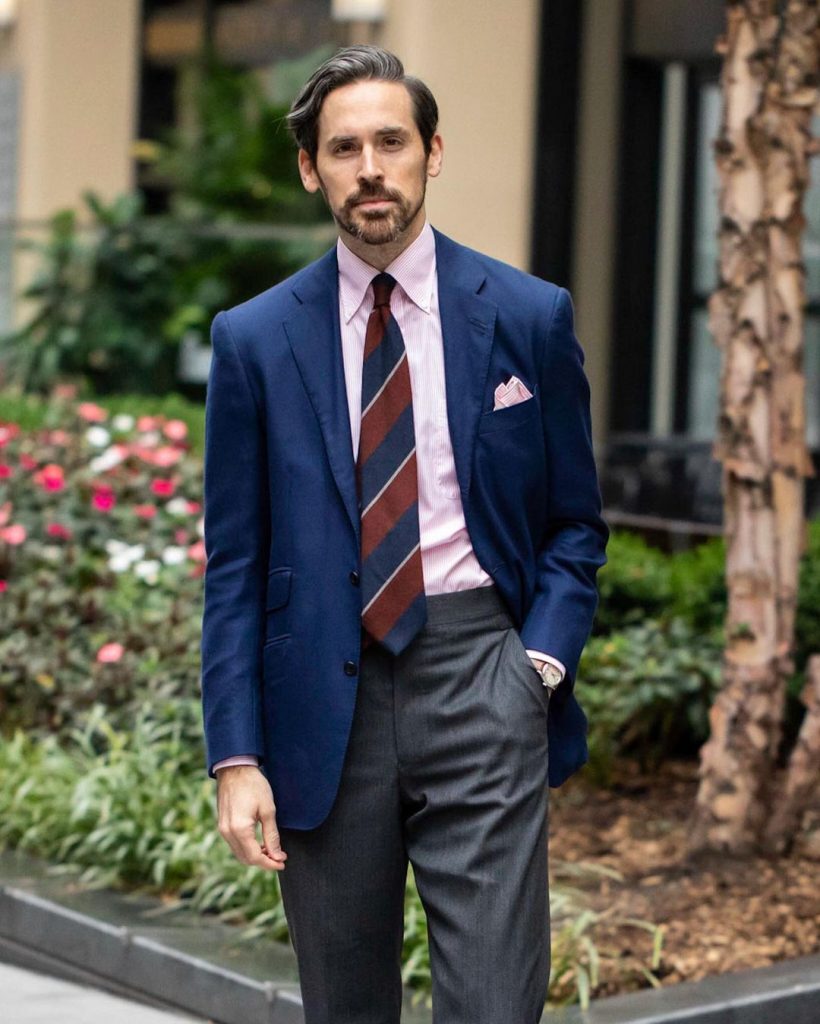
Jonathan Sigmon helms one of the most famous American tailoring shops at a pivotal moment. He’s the new owner of Alan Flusser Custom shop in New York City, taking over the business after serving as Flusser’s right-hand man for nearly seven years. Flusser, as many readers know, is famous for having dressed some of Hollywood’s most iconic characters — Gordon Gekko (Michael Douglas) in Wall Street, Patrick Bateman (Christian Bale) in American Psycho, and Lt. Col. Frank Slade (Al Pacino) in Scent of a Woman. His book Dressing the Man is widely considered to be the Bible of tailored clothing. But with work-from-home arrangements and decades of dress casualization in offices, it’s unclear whether the suit has any relevancy in America’s future. In the summer of 2020, about five months after the first US lockdown was announced, The New York Times prophesized that we’ll be living in sweatpants forever.
For tailoring to survive, I think there needs to be another pop-cultural moment — a film or TV show like Mad Men to inspire people to dress up again. Additionally, tailored clothing needs figures such as Sigmon to help champion the look. Every generation has a unique set of clothiers that introduces them to classic tailoring (e.g. Louis Pearlstein of Louis Boston or Sid Mashburn of the eponymous store). I believe Sigmon is one of those figures. He has years of experience fitting people, recommending fabrics, and helping men and women build wardrobes that make sense for them. On Alan Flusser Custom’s Instagram page, Sigmon shows how you can wear tailored clothing in a way that’s never too “hip” or “gentlemanly.” He pairs sport coats with t-shirts and light-washed jeans, but also knows his way around a more traditional rig. I recently spoke with Sigmon about some of the outfits he’s posted online, asking him to lead me through some of his choices and how he makes tailored clothing feel relevant in today’s very dressed-down world.
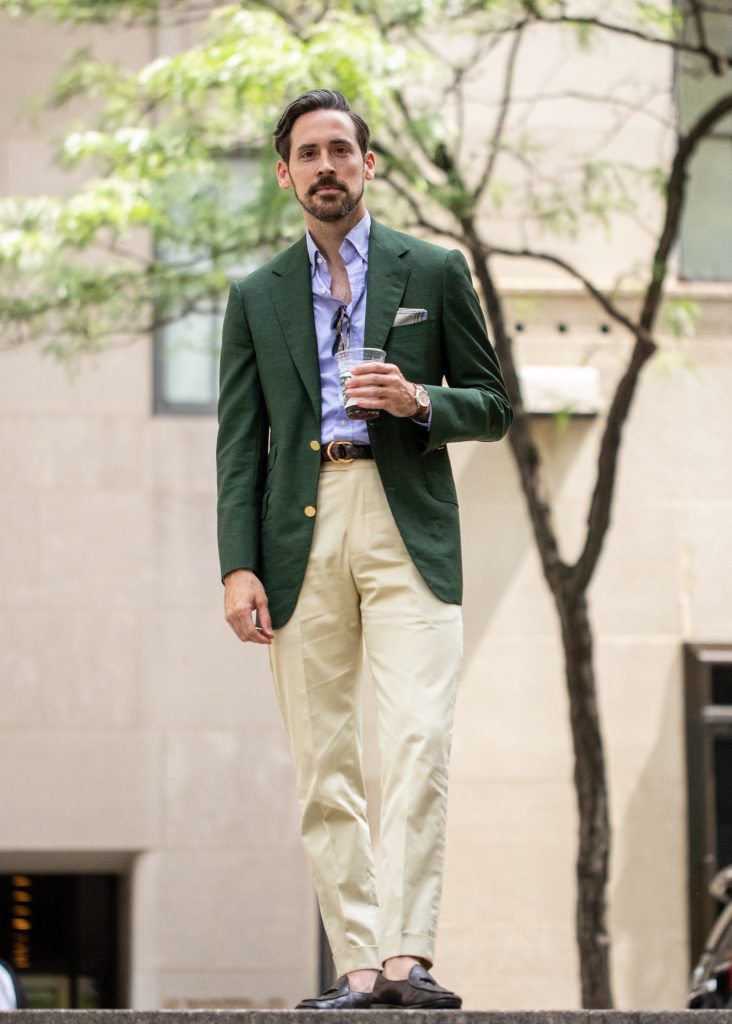
Green Blazers
Derek: Many men are intimidated by blazers, as they find the metal buttons to be too flashy and the style burdened by preppy connotations. Green blazers, in particular, bring to mind Masters’ jackets. Yet, this outfit looks so great. How does one pull off a green blazer?
Jonathan: When I work with someone who needs a dressy blazer but is resistant to the classy navy and brass button configuration, I suggest swapping the brass buttons for gunmetal. Gunmetal buttons are slightly unusual but quite elegant, and they’re a natural pairing with grey trousers, which many men already wear.
When I commissioned this green wool-mohair blazer, I intended to wear it in semi-casual ways. In the photo above, I’m wearing it with cotton gabardine flat-front trousers and a light blue, oxford cloth button-down. That’s about as dressy as I get with it. A couple of years ago, Kirby Allison and I did a video together, where I wore the same green blazer with light-blue jeans, a yellow crewneck, and a brown alligator belt. I think Kirby’s audience leans traditional (I’m generalizing a large group of people here) and I wanted to challenge them with an idea about how to wear a blazer in more casual contexts. I know something like that will be polarizing and I’m not suggesting this is the most “proper” way to wear a blazer. But in the process of developing a personal sense of style, I believe it helps to think about the different ways clothes can be worn.
On the topic of personal style, particularly as it relates to a company such as ours, which remains rooted in the principles of classic tailoring, I recommend Alan’s post titled “Why I Wear What I Wear.” He has a great line in there: “Whether donning black tie or a black cashmere sweater, knowing how they are supposed to button and what liberties you can take without ‘gilding the lily’ is where substantive personal style begins to emerge.” That’s the spirit I take when exploring how to wear things in more casual ways.
I don’t think green blazers are difficult to wear or even evoke the look of Masters’ jackets. Green is our second-most used color for blazers, and for good reasons. It pairs well with a wide range of colors, so you can wear it in the same way you’d wear a navy blazer. It also adds a bit of eccentricity to an otherwise very conservative look. The best way to ease into a green blazer is by aiming for versatility: look for a cloth with texture, such as a wool hopsack or a wool-silk-linen blend, and usually in a darker shade of green.
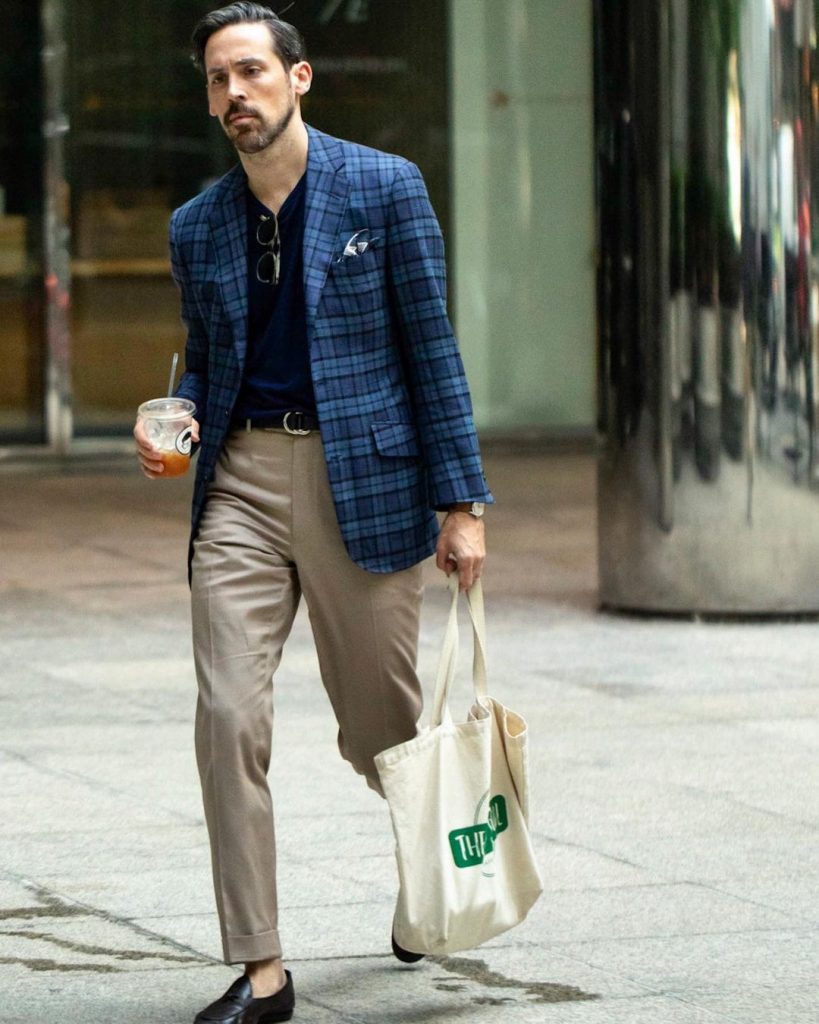
T-Shirts with Tailoring
Derek: I’ve always liked the look of t-shirts with tailoring on other people, but have never been able to figure out how to wear the combo myself. Are there certain details you look for in t-shirts? Is it about the collar line, fabric, or some other detail?
Jonathan: As something of a keeper of the Flusser flame for the next generation, I’ll preface my answer by noting that a good outfit is all about having clothes that are cut in the right proportions and are designed to be flattering on the wearer. After that, you need to be thoughtful about how you approach colors and patterns. Everything we do is rooted in these principles.
That said, when it comes to wearing tailored clothing in more casual ways, I’m not that hung up on the minutiae. If I’m wearing a t-shirt with a sport coat, I embrace that this is a more casual look and just have fun with it. Thinking back on these outfits now, I’ve worn a variety of t-shirts, including sturdy white cottons, textured indigos, Breton stripes, or just fun vintage prints. I usually wear these in the summertime with causal jackets, often things made with unusual plaids or textured fabrics, such as seersucker, slubby silk blends, or wool-silk-linen mixtures. I’m never looking to make an elegant statement with a refined t-shirt; I just wear what feels right to me.
I think it’s more important that folks just grasp what is appropriate for them. L’Etiquette Magazine shows a lot of well-styled tailored clothing with tees, including a French fellow in Issue 07 wearing a sharp Rubinacci suit over a military undershirt tee with a very deep neckline. I’m not cool enough to wear something like that, and I know that about myself. But he looked great. Stuffy people could argue that it is an “inappropriate” pairing, but this is a confident fellow who knows how to wear beautifully tailored clothing in an easy-going way that suits his style. I think that is something worth aspiring to.
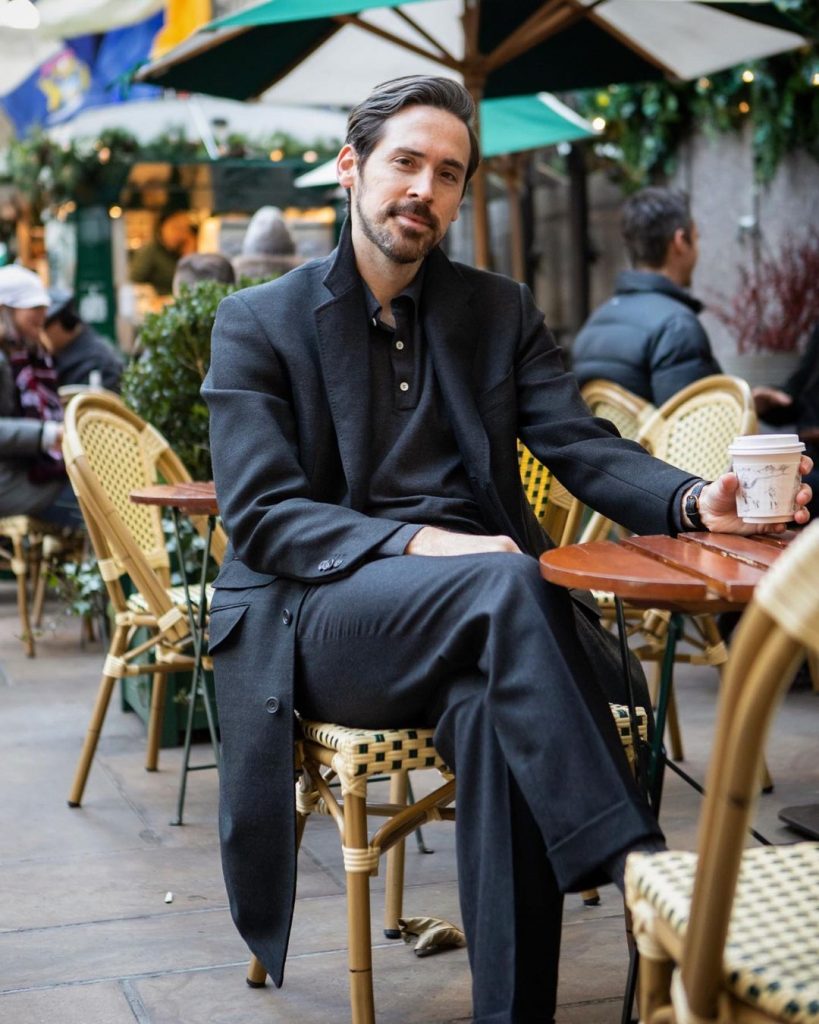
Tonal Tailoring
Derek: Aside from suits, most tailored outfits follow a pretty basic formula — dark jacket, light shirt, dark tie, and medium- to light-colored trousers. Here, you have a tonal outfit combining charcoal, and everything looks harmonious. What is your advice for creating tonal outfits?
Jonathan: This example is more an exception than the norm in how I dress. But every once in a while, particularly as someone who lives in New York City, I just want to wear all charcoal or black. Even something as simple as the mother-of-pearl buttons on the knit pullover here keeps the outfit slightly interesting, considering that everything else is soft, matte, and in a very similar color.
When you wear tonal outfits, it helps to get variation from something other than color, such as texture, pattern, or sheen. This spring, I plan to wear a pair of tan wool-mohair trousers with a lightweight, cashmere-silk sport that has a light gold base and subtle windowpane check. I like wearing this combination with a white Capri collar shirt or a linen button-down, and then light brown suede Belgian slip-ons or off-white espadrilles. Although the colors here are similar, you get variation through the textures, patterns, and fibers of the materials.
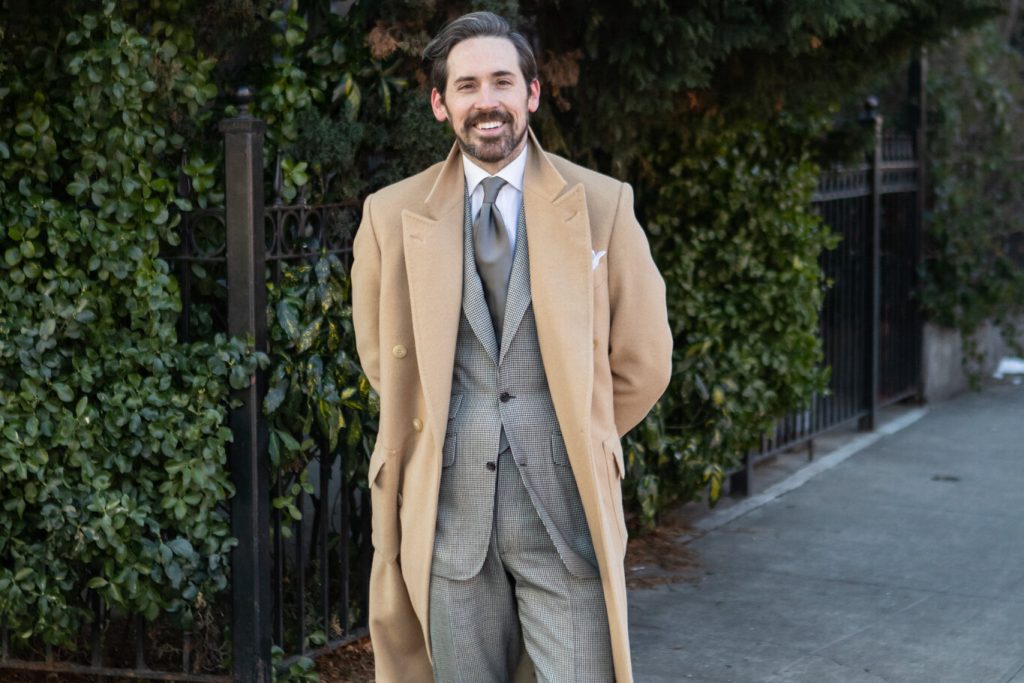
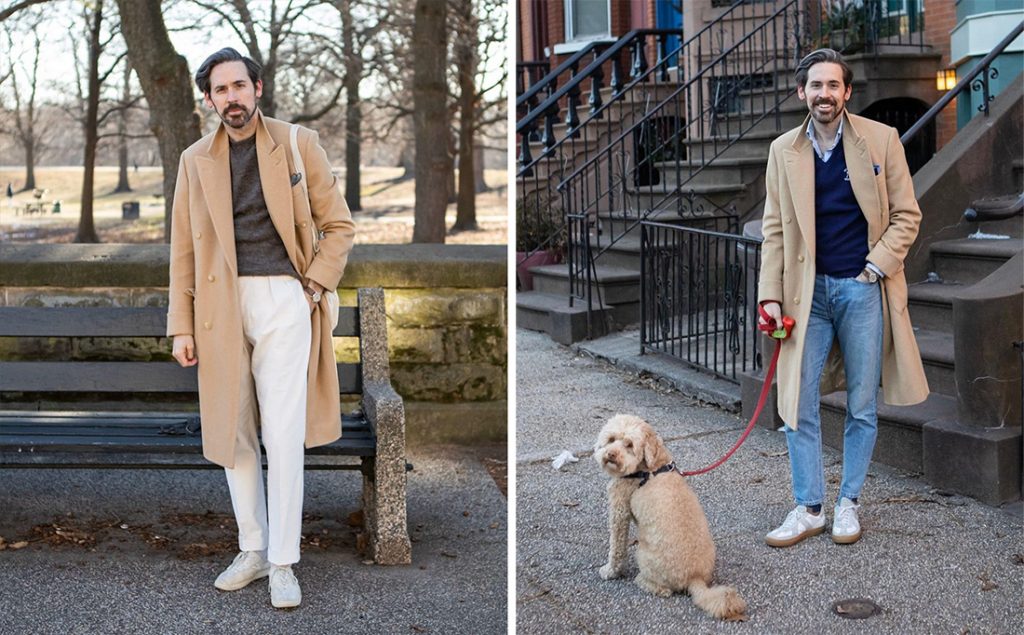
Overcoats with Casual and Formal Outfits
Derek: These are my favorite photos of the bunch. I love how you wear a polo coat with more formal and casual outfits. What should people look for when shopping for a versatile overcoat?
Jonathan: A polo coat is definitely the “house choice” for an overcoat that’s versatile. Nothing else pairs as well with jeans and a sweater as it does with more formal clothing. Otherwise, when aiming for versatility, I like having a bit of contrast between the formality of the coat and the fabric. We just finished making an overcoat for a client who wanted something he can wear with a wide range of things. This coat has a double-breasted closure, peak lapels, and slanted flap pockets. We made it using a light brown Loro Piana Pecora Nera wool with a wide herringbone pattern.
On the flip side, we often make car coats from pure cashmere. We like our car coats to be a touch longer than what you commonly see these days, but it’s still a rather casual overcoat made from luxurious fabric. These two coat models come at things from different ends of the spectrum, but depending on the fabric choice, they can be wearable in a wide variety of settings because of how they combine the coat style with contrasting formality in fabric choice.
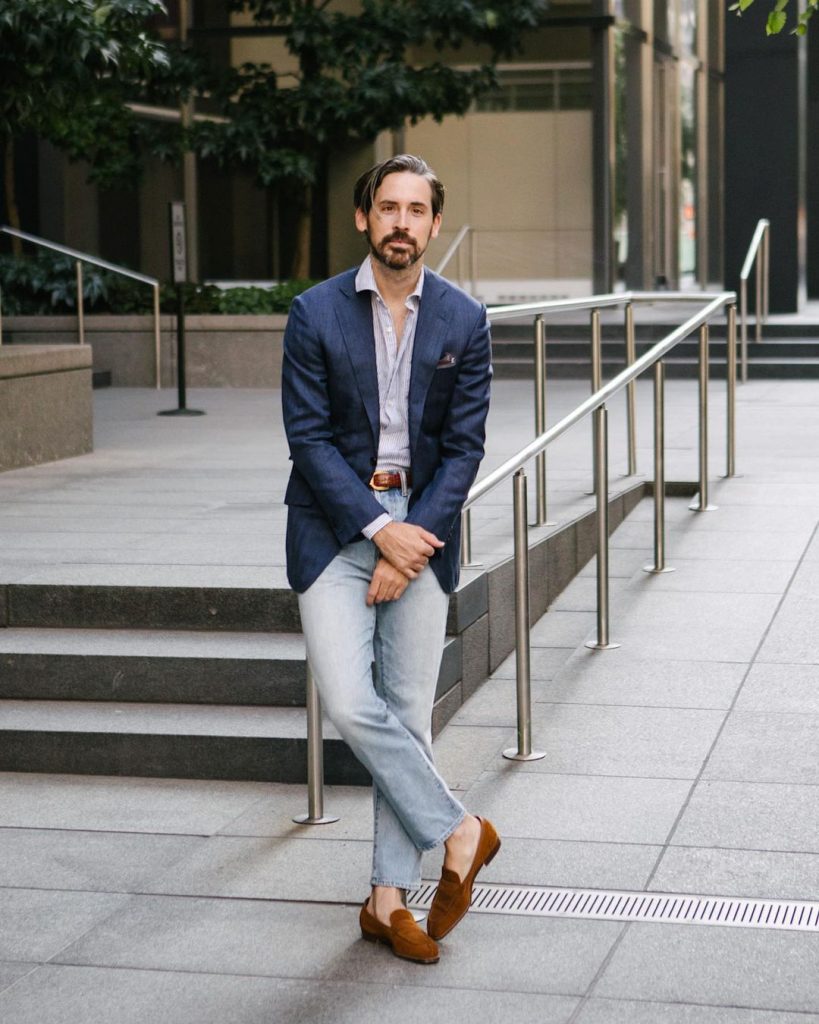
Tailoring with Denim
Derek: A lot of guys try wearing sport coats with jeans because they think it helps dress down the jacket, but the combo is often trickier than just wearing the jacket with wool trousers. Do you have advice on how to combine denim with tailoring?
Jonathan: Like other things we’re discussing here, this is partially about confidence and one’s comfort level in pairing “high and low” pieces together. There are a lot of ways to wear jeans with a tailored jacket well. I prefer heavily worn denim or light washes if I’m wearing a jacket, for similar reasons to the t-shirt topic. Just as I’m not necessarily trying to formalize or dress up a tee, I’m usually not aiming to make an outfit with jeans smarter by wearing a new pair of dark, raw denim. That just doesn’t interest me these days. I understand it’s inherently casual to wear jeans, so if I wear jeans with a tailored jacket, I’d rather use the opportunity to show my style. This is my preference, but someone at a creative agency might wear a dark pair of jeans and a navy blazer with dark horn buttons, which is a very simple and chic look that is completely appropriate for that person’s setting and lifestyle.
As far as fit, my jeans are usually relatively tapered. On the other hand, you have folks like Ethan Newton and Henrik Wilberg, who offer excellent examples of how to wear relaxed straight-cut jeans. Those types of jeans can look great with a tailored jacket because they mix up the proportions. I’ve tried it a time or two, and it hasn’t felt natural to me, so it’s just not how I do it these days.
In the photo above, I’m wearing 90s Gap jeans. They’re not actually from the 90s; that’s just the name of the model. I bought them new a couple of years back, and I have our photographer Chris Fenimore to thank for the tip on finding those. I think they were on sale for 25 bucks, and I bought two pairs and wear them all the time. While I love them, they’ve also reminded me of the difference between a pair of jeans from a place such as The Gap and the better quality denim I’ve been wearing over the last decade (usually 3Sixteen). These are quickly falling apart, and I’m on the hunt now for a replacement.
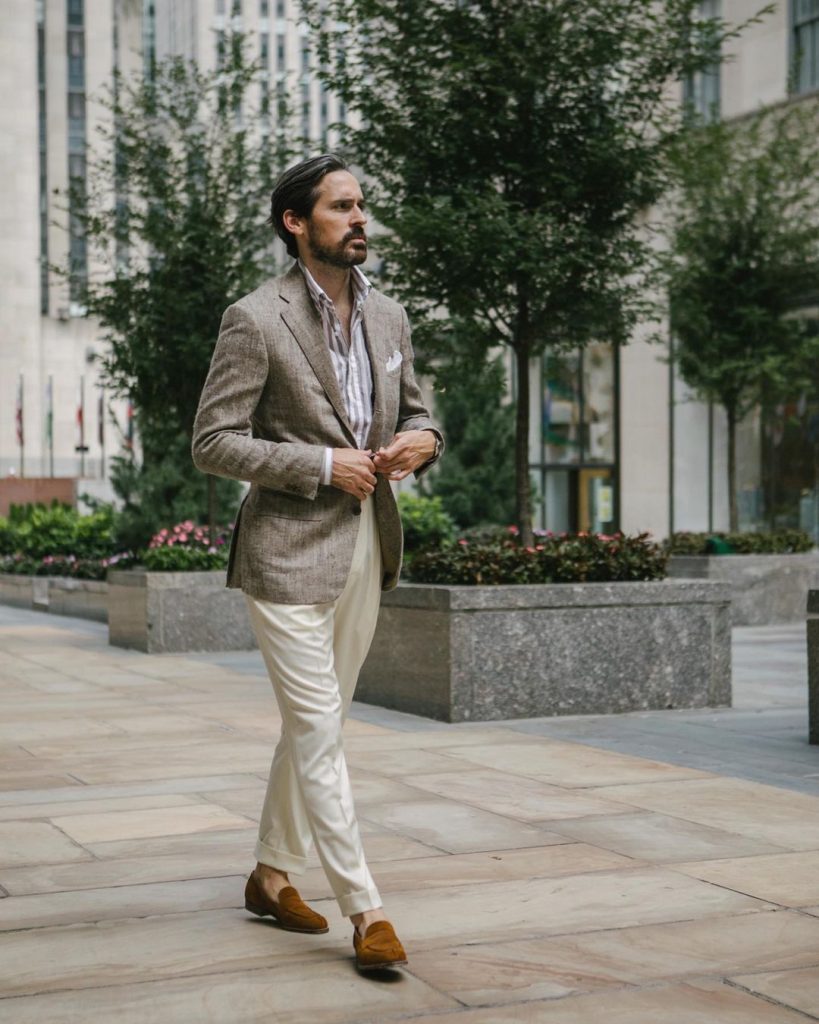
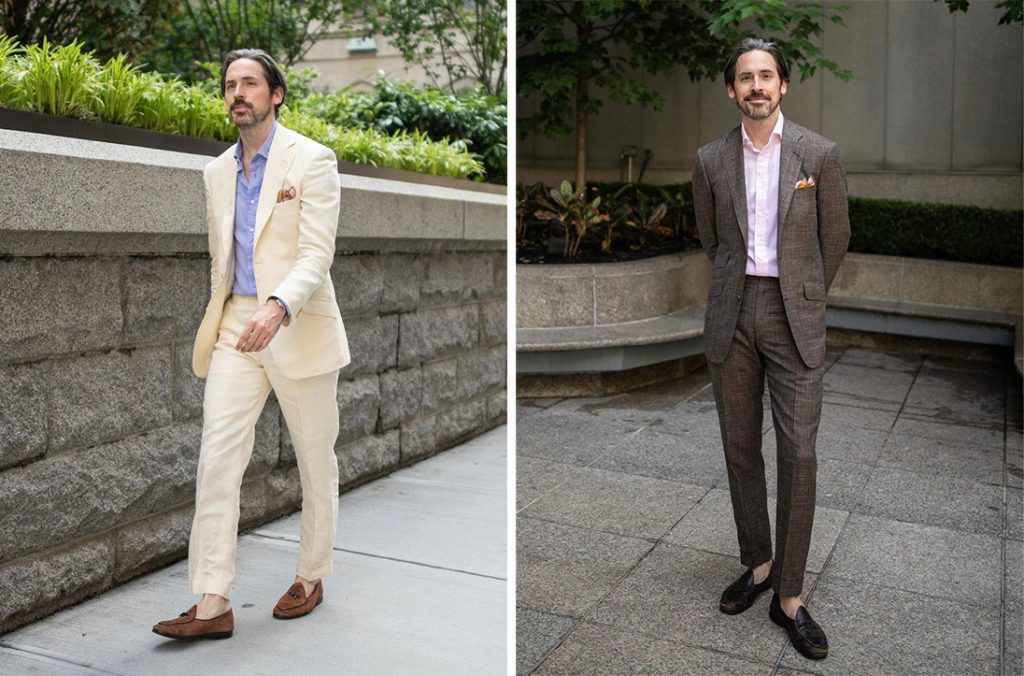
Favorite Spring/ Summer Fabrics
Derek: Since we’re heading into spring, I’m curious to hear your favorite fabrics for the warmer seasons. I feel like fall/winter fabrics are obvious: tweed, flannel, corduroy, etc. For spring/ summer, many guys struggle to think of materials beyond tropical wool and linen. What fabrics do you wear in the spring/ summer?
Jonathan: This is a tough topic, as the answer will depend on a lot of things. I would recommend different fabrics depending on the garment — business suits to casual suits, sport coats to alternative jackets. I would also have different recommendations from one client to the next based on their needs and how they like to wear their clothes.
The easiest answer is that we almost always suggest wool-silk-linen blends for jackets. The silk and linen mixture will lend a lovely texture and character. If the fabric has over 50% wool in the mixture, it will also be relatively resistant to wrinkles. We often turn to Loro Piana and Caccioppoli for these fabrics, as they have a wide variety of wool-silk-linen blends in various weaves, colors, and patterns. Beyond that, to try to offer something of an answer, here’s what I’m contemplating for our spring/ summer showroom samples right now.
First, I’m thinking of two fabrics for trousers. The first is a relatively lightweight, 8oz wool-mohair blend in a 60/40 mixture. This comes in a light tan color. I love the idea of wearing super crisp, tan wool trousers in the summertime instead of the usual cotton chino, linen, or lightweight gabardine. The second fabric is a heavier 13oz pure linen that comes in mid-gray. Given its weight, it will rumple more than wrinkle. I’m using this as an experiment to see how I like robust linen pants throughout late spring and early fall.
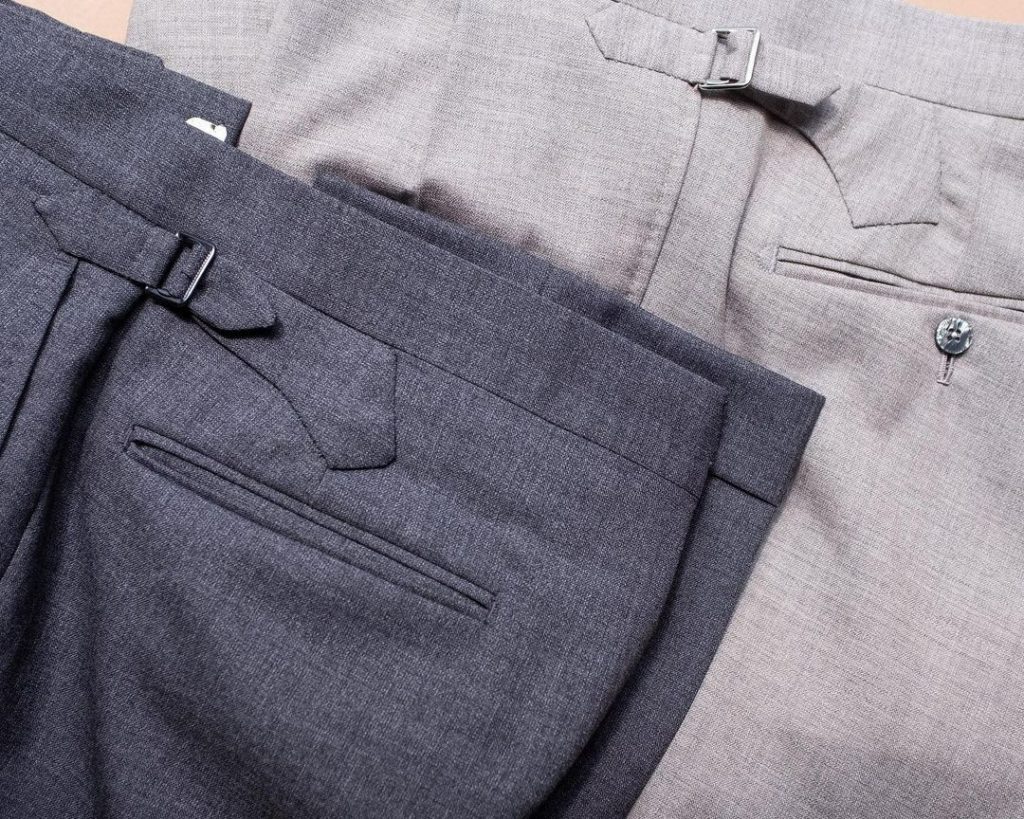
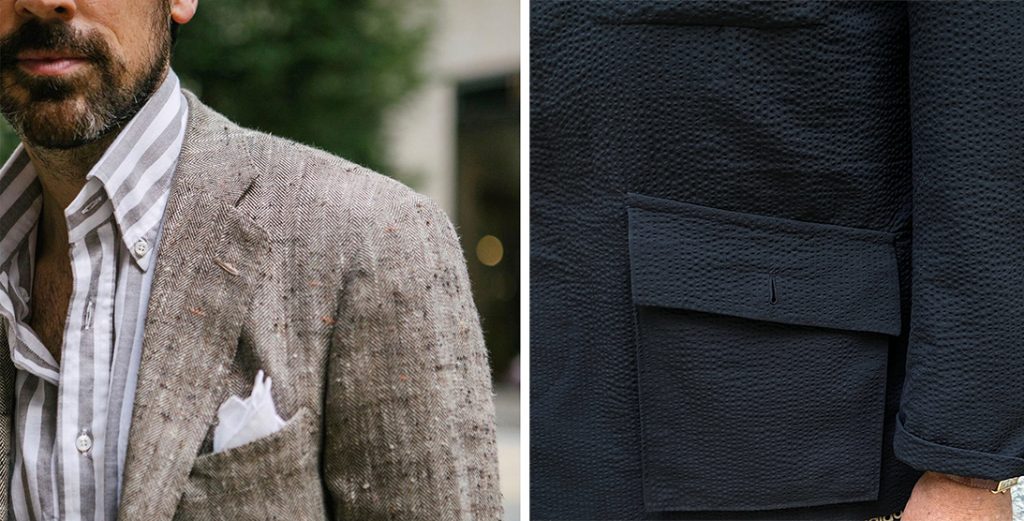
For jackets, I’m looking at an 11oz linen. I’ve been on a slate blue and tan/ gold kick, so you’ll be seeing a lot of these colors from me. This one is from Maison Hellard, a new merchant who launched last year with a lovely Italian-made linen collection. For me, 11oz is the sweet spot for linen, as it will hang well but still be lightweight enough to wear during peak summertime. I’m also looking at a light gold windowpane in 7oz cashmere-silk. It’s incredibly elegant; a very Palm Beach piece.
Finally, I’m thinking about getting a Solaro suit in an 8oz wool-silk fabric. Drapers has a lovely new fabric collection full of Solaro-esque fabrics made with rich, subtly iridescent colors and striking herringbones. It’s nice to make something like this with minimal lining to take advantage of the different colors on the reverse side of the cloth. Additionally, I’m looking at Drapers’ mid-gray 8oz high-twist open weave wools for a trouser and a suit. Their high-twist wools are amazing. Last year, I wrote an article about them and called the fabric “the perfect pant.” It’s robust enough to hang nicely and performs better than some of the lighter-weight tropical wools. Yet, it’s still a weight that I find tolerable on even the hottest of days.
Unlike some of our other friends in the industry, neither Alan nor I have ever been keen on heavy open-weave fabrics for summer. I know they will hold their shape very well, and I know they are pretty breathable. So on a breezy day, you may still keep cool if you’re staying in the shade. However, in NYC, when it’s 90 degrees, and the sun is beating off the pavement, and the air isn’t moving, it just feels like you’re wearing a blanket. We once had a client who asked us to get a 16oz hopsack from an English mill. This fabric was suggested to them by the head of a Savile Row tailoring firm, and the client wanted to get our thoughts. Alan told him he wouldn’t make a garment out of that fabric for his worst enemy.
My favorite book for summer fabrics is Loro Piana’s Mare. You could build an entire summer wardrobe from that book. They have wool-silk seersucker, wool-silk-linen blends, pure silk Dupioni, silk-linen blends, pure cottons, etc. A couple of years ago, we were the biggest buyer of the wool-silk seersucker among US tailors. We love that fabric and use it all the time. It may not be the piece that you pass down to your son in twenty years, but if you have to wear a jacket when it’s 90 degrees outside, there is absolutely nothing better. We commissioned an exclusive 100-meter piece of that wool-silk seersucker in black after impatiently waiting several years, hoping Loro Piana would release it in their primary collection. Of course, you don’t usually think of black when you think of seersucker, but we think it’s a super cool take on a classic. Clothes should be enjoyable. Wear an all-black seersucker suit to your summer evening cocktail-attire event and have fun with it.
Many thanks to Jonathan for his time! Readers interested in Alan Flusser Custom can follow them on Instagram and read their blog. They have a showroom in New York City, located at 3 East 48th Street, Floor 3, where they offer custom tailoring. Made-to-measure suits start at $2,500, sport coats at $1,600, and shirts at $225. Additionally, they hold trunk shows in select cities across the United States and offer a small line of ready-made accessories, which you can order directly from their website.







